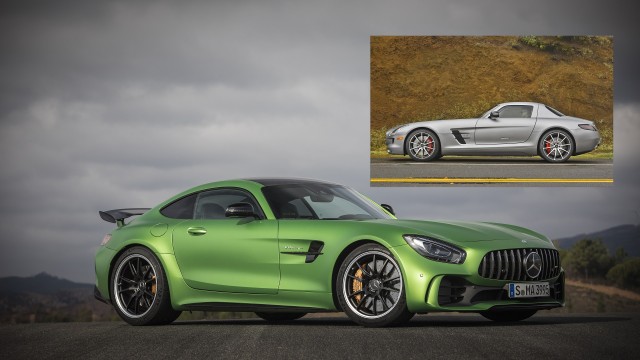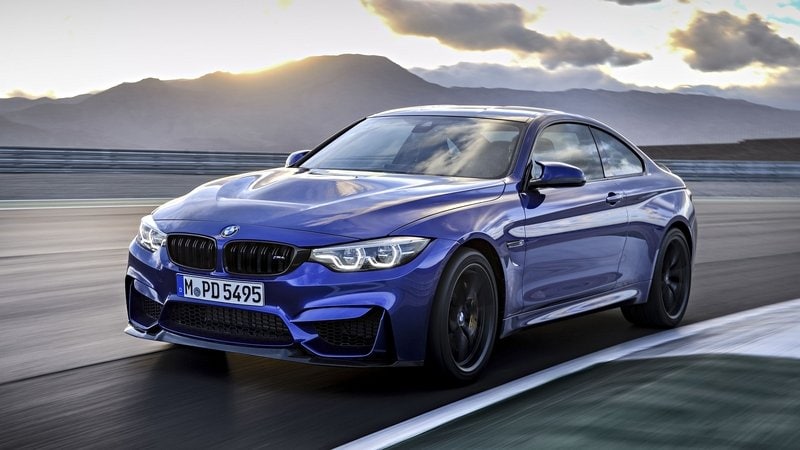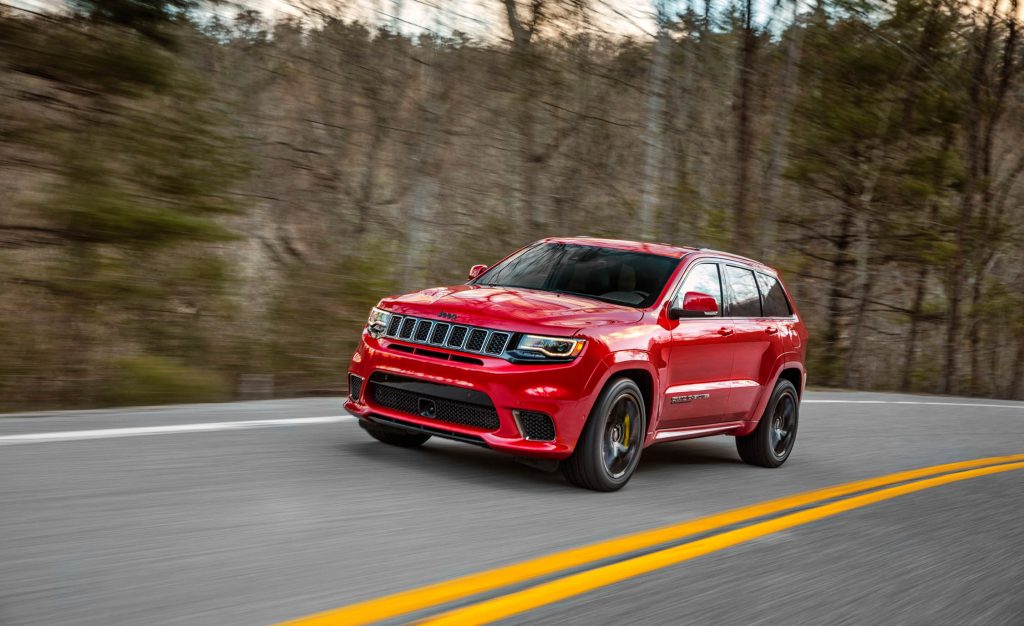
How the Mercedes-Benz SLS AMG evolved into the Mercedes-AMG GT
April 10, 2017
The Brand-New BMW M4 CS Is A GTS Without The Big Wing
April 24, 2017Dodge’s 707-hp Challenger and Charger Hellcat models are loud, instigate bad behavior, and can generate local, rubber-sourced cloud cover with merely a stab of their gas pedals. They’re the vehicular equivalents of a Daytona Beach spring-break hookup, the sort of ride that your dad might high-five you (behind Mom’s back) for buying. But what if there were a Hellcatted vehicle tame enough, relatively speaking, to bring home and introduce to Mother?
The Jeep Grand Cherokee Trackhawk is the third Fiat Chrysler vehicle to have the unhinged supercharged V-8 stuffed under its hood, and it’s the quiet Hellcat next door. Not literally, of course—have you heard a blown Hemi V-8 at full whack?—but with standard all-wheel drive mitigating the engine’s tire-spinning proclivities, plus its under-the-radar looks, the Trackhawk can at least pass for an upstanding citizen.
With more traction than any Hellcat yet, the Trackhawk has quite a lot of poke despite its pork—the engine adds 259 pounds over the already heavy 475-hp Grand Cherokee SRT. Nonetheless, Jeep claims it can reach 60 mph in 3.5 seconds. That time is on par with the nearly 1000-pounds-lighter, automatic-equipped Dodge Hellcats we’ve tested. (The quickest was the Charger, which reached 60 mph in 3.4 seconds.) Per Jeep, the quarter-mile is expected to fly by in 11.6 seconds (at 116 mph!), and, with no electronic governor, the Trackhawk is said to surrender to atmospheric resistance at 180 mph.
Demonic Possessions
Helping this SUV move out in a hurry is a Torque Reserve launch-control feature that briefly holds the supercharger bypass valve open while cutting spark and fuel to specific cylinders to limit torque before the brake is released. This widget is shared with the Dodge Challenger SRT Demon, as is an A/C evaporator for cooling the intake charge.
The supercharged 6.2-liter Hemi V-8 is mostly left alone otherwise, right down to its forged pistons, sodium-filled exhaust valves, heavy-duty bearings, and blower pushing as much as 11.6 psi. Exhaust-routing complications reduce peak torque by a negligible 5 lb-ft, to 645. To keep the Hellcat from lunching the Trackhawk’s driveline, Jeep fortifies the eight-speed automatic transmission, fits forged chain sprockets and a wider chain in the transfer case, beefs up the rear driveshaft and half-shafts, and tweaks the rear differential.
In normal operation, the transfer case’s 40/60 front-to-rear torque split is the same as in the Grand Cherokee SRT; ditto the Sport mode’s 35/65 split, the Track setting’s 30/70 division, and Snow mode’s 50/50 apportionment. The Tow mode has a 60/40 split, but what’s more notable is the very idea that this Hellcat is rated to tow. It is! Owners can drag along up to 7200 pounds, which equates to either another Hellcat-powered creation or the weight of expectations for a Hellcat-powered SUV.
Outside the Engine Bay
According to Mopar’s performance catalog, the iron-block Hellcat V-8 engine and supercharger together weigh 800 pounds. That’s vastly heavier than the 6.4-liter Hemi in the Grand Cherokee SRT. To compensate for the Trackhawk’s additional mass, the engineers stiffened the front springs by 9 percent and the rears by 15 percent, and fiddled with the electronically adjustable Bilstein dampers. The only other chassis changes are wider front and rear tracks (by 1.3 inches and 0.1 inch) relative to the SRT, and 0.75-inch-larger front brake rotors. Like the optional Brembo brake package on the SRT, the Trackhawk’s front rotors are two-piece units gripped by six-piston calipers (here painted yellow instead of red).
Just as the regular SRT defies physics, posting 0.87 g on our skidpad and braking from 70 mph in 168 feet in a recent test, so, too, does the Trackhawk. Jeep’s claims for the beast’s grip around a skidpad of unspecified diameter (we use a 300-foot pad) and braking from 60 mph (we test from 70 mph) are 0.88 g and 114 feet. We gather from these figures that the Trackhawk should be as surprisingly capable as the SRT model is on a track, although drivers likely will experience higher speeds between corners.
For a Jeep with 707 horsepower, the Grand Cherokee Trackhawk is remarkably incognito. Only a few badges that read “Supercharged” and “Trackhawk,” as well as the Hellcat-specific yellow brake calipers, quad exhaust outlets instead of two, and exclusive 20-inch wheels set the Trackhawk apart from the SRT. Airflow requirements for the engine also dictated the deletion of the SRT’s fog lights from the outboard front intakes.
Inside, only a winged Trackhawk badge on the steering wheel sets the mightiest Jeep apart—well, that and the 200-mph speedo. The same active noise cancellation, stitched-leather dashboard and door panel coverings, Berber carpets, and 8.4-inch Uconnect infotainment display as the SRT are included. (Jeep adds a dyno function for instantaneous horsepower and torque readouts to Uconnect’s Performance Pages app.) Apple CarPlay and Android Auto are standard, as well, for anyone who cares about such things when purchasing a 707-hp SUV. Ditto the adaptive cruise control, blind-spot monitoring, parking sensors, lane-departure warning, and forward-collision warning. Then again, this equipment ought to be included, given that the Trackhawk is expected to cost somewhere around $80,000.
Somehow, even with so many big numbers floating around in this Jeep’s speech bubble, its arrival borders on the mundane. We’ve been waiting years for the Hellcat to find its way into the Grand Cherokee’s engine bay. Now it’s here. The flatness with which that realization hits is partly the fault of the Hellcat’s normalization, the feeling that, three years after the engine’s debut, 707-hp mainstream vehicles are a part of everyday life. After all, there’s now an even more powerful version of this V-8 in the 10th-circle-of-hell Challenger Demon.
Easily lost in all of this is the Trackhawk’s hegemony over the SUV dominion. Move over, Bentley Bentayga, any Porsche Cayenne, and even the weirdest versions of Mercedes-Benz’s G-class—the most powerful SUV in the world, by far, wears a Jeep badge. That alone brings some of the Hellcat’s original aura of crazy to the Trackhawk, even if it can’t spin those big tires the way its Dodge siblings can unless it’s chained to something. The sensible Hellcat? Better to call it the least crazy Hellcat, or the wildest production Jeep ever.
Source: caranddriver.com

